Ruine del Tempio di Ercole Callaico (original) (raw)
Links to this page can be found in Book 3, Day 2, View B8 and Rione Monti.
The page covers:
[The plate by Giuseppe Vasi](#The Plate)
Today's view
"Tempio di Minerva Medica"
Works of art from Horti Liciniani
The Plate (No. 49 - ii)

Templum Herculis Callaici. It stands in the vineyards near S. Bibiana. A very tall building of brick not exactly round but decagonal. The roof of it is a vault or cupola not so great as that of the Rotonda and yet not much less.
John Ray - Observations (..) made in a journey through part of (..) Italy in 1663
At Vasi's time this large circular building was thought to be a temple to Hercules built by Decimus Junius Brutus, a Roman general who in 137 BC led a series of campaigns in the north-western part of the Iberian peninsula where a region of Spain is still known as as Galicia. The Roman Senate granted him the title of Callaicus. The building was also known as Tempio di Minerva Medica after a statue which was reportedly found there at the beginning of the XVIIth century (but today archaeologists believe it was found elsewhere, perhaps at [Campo dei Fiori](Vasi28.html#The Plate) or at [Piazza della Minerva](Vasi156.htm#S. Maria sopra Minerva)): it portrayed the goddess with a snake, a symbol of Medicine. It is known as Athena Giustiniani because it was part of the Giustiniani collection. You may wish to see a bronze head of Minerva Medica which was found at Bath.
The small 1748 map here below shows 1) Tempio di Minerva Medica; 2) [S. Bibiana](Vasi06.htm#S. Bibiana) which is covered in another page.
Today
The view in May 2009
That the edifice could not have been a temple is clear from the fact of its wanting the constituent parts of a temple.
Rev. Jeremiah Donovan - Rome Ancient and Modern - 1843
The nymphaeum stands close to the Tre Archi, by which all the railway lines enter the city and is the first ruin to strike the eye of the stranger on his entering the walls of the Eternal City.
Rodolfo Lanciani - The Ruins and Excavations of Ancient Rome - 1897
The ruins are now imprisoned between a tramway leading to Porta Maggiore and the rail track leading to Stazione Termini and yet they still call for admiration. Until recently the building was thought to be a nymphaeum, a monumental fountain, but today it is believed to have been a hall for entertaining guests.
"Tempio di Minerva Medica"
View of the side where the vault collapsed
The ruin called the temple of Minerva Medica is evidently situate in the locality of the gardens, and therefore, in all probability, formed part of the Palatium Licinianum. (..) Its vaulted cieling fell in 1828; and it was since then struck with lightning. Its construction denotes the time of the decline, and is not unlike the so called [Torre de' Schiavi](Preneste.html#Tor de' Schiavi) and other ruins built by Gordian III, who was killed nine years before Gallienus was associated to the empire by his Father in 253. The colour imparted to the edifice by time, its site, the shrubs that have sprung up on its ruined vaulted cieling, render it picturesque; and it has therefore been frequently painted and engraved. Donovan
The building stands on the area of Horti Liciniani, a large villa belonging to the Licini, the family of Emperor Licinius Gallienus, whose assumed tomb along Via Appia has a round structure. The Emperor could access his estate through an [old triumphal arch](Vasi126.htm#The Arch of Gallieno) which was rededicated to him. The most recent studies on the building however came to the conclusion that it was erected in the early IVth century at the initiative of Maxentius or Constantine, similar to a [large basilica in the Roman Forum](Vasi102.htm#Tempio della Pace).
Interior
Its plan is a decagon, the lower part of which is occupied by nine large niches and a door, which corresponded with ten arched windows over them. Donovan
The drum has the shape of a decagon and it supports a concrete dome having a diameter of 25m/82ft, the largest one of ancient Rome after those of the Pantheon and of the calidarium of Terme di Caracalla. The construction technique is different, much lighter than that of the Pantheon and with large windows; it recalls the Baths built by Constantine at Trier.
The nymphaeum was once covered with mosaics and slabs of porphjry, and its dome incrusted with shells and enamel. The vignettes of the sixteenth and seventeenth centuries show it in a much better state of preservation. (..) It was first excavated, as far as we know, (..) at the time of Julius III. The produce of the excavations is described by Ligorio, and his statements are substantially corroborated by Flaminio Vacca. Numbers of statues were discovered lying in pieces before their respective niches. Lanciani
Buttresses on the northern side
Archaeologists have come to the conclusion that the vault partly or totally collapsed during the IVth or the Vth century and that, after it was repaired, buttresses were added between the windows to strengthen the structure of the building. With the [move of the capital to Constantinople](Storia11.html#Nova Roma), the emperors very rarely lived in Rome and the economy and population of the city declined. The building was probably abandoned before the Greek-Gothic War led to the destruction of the aqueducts which supplied water to this part of Rome.
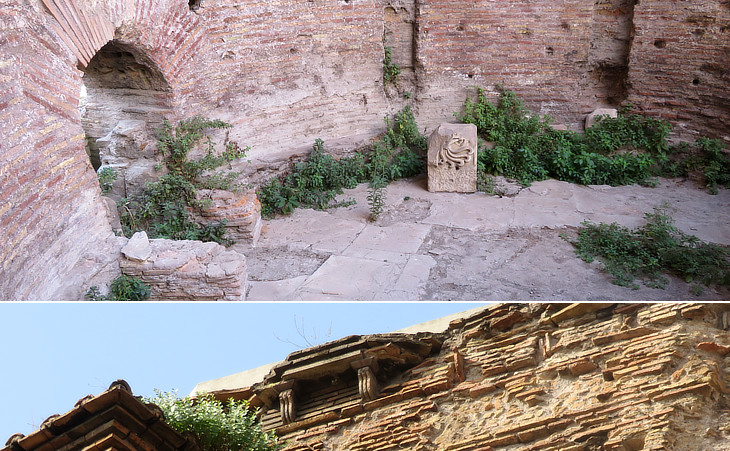
(above) Evidence of heating system in one of the niches, which most likely housed the couch of the emperor/landlord; (right) remaining decoration of the external cornice of the dome
It is no wonder that, after so many finds, our own excavations in 1875-78 shold have led to no results. The only objects recovered were the bust of Manlia Scantilla, wife of the Emperor Didius Julianus, now in the Palazzo dei Conservatori, some fanciful capitals and columns with Bacchic reliefs, and two statues of Roman magistrates of the fourth century. Lanciani
The image used as background for this page shows arches supporting the dome.
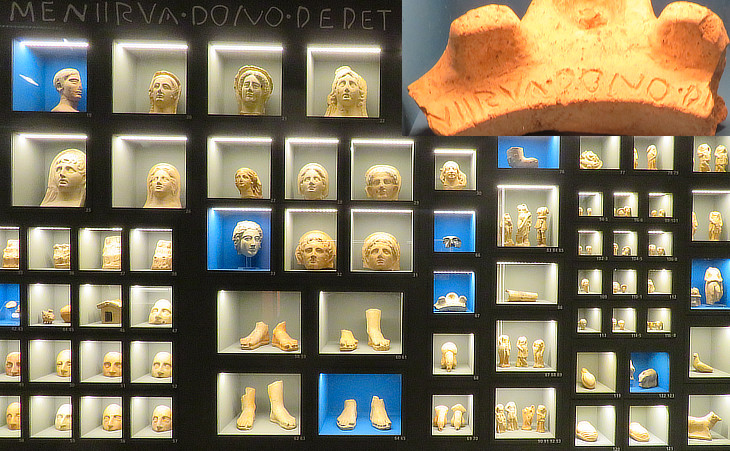
Temporary exhibition at Musei Capitolini: terracotta objects from a shrine dedicated to Minerva; (inset) fragment of a lamp with a dedicatory inscription
During these last years I have been present at the discovery of five deposits of ex-votos, each marking the site of a place of pilgrimage. (..) The name of Minerva Medica is familiar to students and visitors of old Rome; but the monument which bears it, a nymphaeum of the gardens of the Licinii, near the Porta Maggiore, has no connection whatever with the goddess of wisdom. Minerva Medica was the name of a street on the Esquiline, so called from a shrine which stood at the crossing, or near the crossing, with the Via Merulana, not far from the church of SS. Pietro e Marcellino. Its foundations and its deposit of ex-votos were discovered in 1887. The shape and nature of the offerings bear witness to numberless cases of recovery performed by the merciful goddess, the Athena Hygieia or Paionia of the Greeks. There is a fragment of a lamp inscribed with her name, which leaves no doubt as to the identity of the deposit.
Rodolfo Lanciani - Pagan and Christian Rome - 1892
Works of Art from Horti Liciniani
(left) Centrale Montemartini: three statues found in 1887 at Horti Liciniani: they portray (left to right): Dionysus, a satyr and a seated maiden; (right) Museo Nazionale Romano: head of Emperor Hadrian which was found near Tempio di Minerva Medica
Whenever he (Gallienus) went to the gardens named after him, all the staff of the Palace followed him. And there went with him, too, the prefects and the chiefs of all the staffs, and they were invited to his banquets and bathed in the pools along with the prince. Women, too, were often sent in, beautiful girls with the emperor, but with the others ugly old hags.
Historia Augusta - Volume III - translation by David Magie - Loeb Classical Library.
The statues found inside Horti Liciniani were made at the time of Emperor Hadrian, more than a century before Gallienus rose to power. They perhaps belonged to a previous wealthy owner of the gardens.
Centrale Montemartini: mosaic found in the area of Horti Liciniani and details showing a boar hunting scene
A large mosaic was found in 1904 in the proximity of Tempio di Minerva Medica. It is the same age as the building and it suggests that at that time Horti Liciniani were most likely part of a [property belonging to Emperor Constantine and his mother Helena](Vasi47.htm#Temple of Venus).
Centrale Montemartini: other details of the mosaic
The style of the mosaic departs from traditional patterns as it lacks an elaborate frame and the figures are depicted against a white background (similar to Mosaico del Gladiatore). The hunters all wear heavy clothes which is another remarkable deviation from tradition. Some details recall scenes of a large mosaic of the palace of Emperor Justinian at Constantinople or one at Villa del Casale in Sicily and more in general Roman mosaics of Algeria and Tunisia.
Horti Sallustiani, [Horti](Vasi126.htm#Horti di Mecenate)[ di Mecenate](Vasi126.htm#Horti di Mecenate), Horti Lamiani and Horti Serviliani are other ancient villas within or immediately outside the walls of Rome where many fine works of art were found.
Next plate in Book 3: [SS. Pietro e Marcellino](Vasi50.htm#The Plate).
Next step in Day 2 itinerary: Trofei di Mario.
Next step in your tour of Rione Monti: [Chiesa di S. Prassede](Vasi127a.htm#The Plate).
Excerpts from Giuseppe Vasi 1761 Itinerary related to this page:
###### Tempio di Minerva Medica
##### E' questo di figura rotonda fatto di mattoni, rovinato solamente verso levante: alcuni per� lo credono di Ercole Callaico eretto da Giunio Bruto per aver soggiogato i Callaici popoli della Spagna.